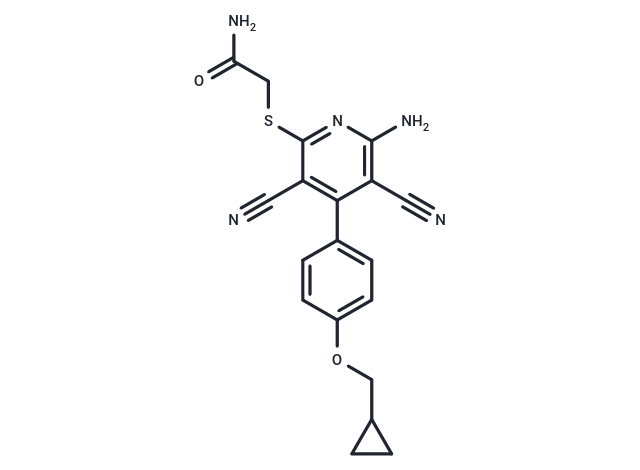Shopping Cart
Remove All Your shopping cart is currently empty
Your shopping cart is currently empty
BAY 60-6583 is a potent, high-affinity adenosine A2B receptor agonist (EC50 = 3 nM) with affinity for A2B receptors that exceeds that for A1, A2A, and A3 receptors.BAY 60-6583 is cardioprotective in a model of myocardial ischemia.The Ki values for BAY 60-6583 binding to mouse, rabbit, and dog A2BAR were 750 nM, 340 nM, and 330 nM, respectively. The Ki values of BAY 60-6583 binding to A2BAR in mice, rabbits and dogs were 750 nM, 340 nM and 330 nM respectively.

| Pack Size | Price | USA Warehouse | Global Warehouse | Quantity |
|---|---|---|---|---|
| 1 mg | $35 | In Stock | In Stock | |
| 2 mg | $48 | In Stock | In Stock | |
| 5 mg | $80 | In Stock | In Stock | |
| 10 mg | $125 | In Stock | In Stock | |
| 25 mg | $258 | In Stock | In Stock | |
| 50 mg | $418 | In Stock | In Stock | |
| 100 mg | $629 | - | In Stock | |
| 200 mg | $886 | - | In Stock | |
| 1 mL x 10 mM (in DMSO) | $108 | In Stock | In Stock |
| Description | BAY 60-6583 is a potent, high-affinity adenosine A2B receptor agonist (EC50 = 3 nM) with affinity for A2B receptors that exceeds that for A1, A2A, and A3 receptors.BAY 60-6583 is cardioprotective in a model of myocardial ischemia.The Ki values for BAY 60-6583 binding to mouse, rabbit, and dog A2BAR were 750 nM, 340 nM, and 330 nM, respectively. The Ki values of BAY 60-6583 binding to A2BAR in mice, rabbits and dogs were 750 nM, 340 nM and 330 nM respectively. |
| Targets&IC50 | A2B:3 nM(EC50), A2BAR (mouse):750 nM, A2BAR (rabbit):340 nM, A2BAR (dog):330 nM |
| In vitro | BAY 60-6583(0-10 μM) exhibits the maximum agonist effect of BAY 60-6583 in the absence of siRNA is 68 %.[3] BAY 60-6583 (5 μM; 24 h) induces a rise in cell accumulation within the G1 phase while concurrently reducing the G2/M phase in RAW264.7 preosteoclasts. Additionally, under the same conditions, BAY 60-6583 specifically impedes Akt activation triggered by M-CSF, with no discernible impact on M-CSF-induced ERK1/2 activation in RAW264.7 preosteoclasts.[4] |
| In vivo | BAY 60-6583 (100 mg/kg; intravenous injection; rabbit) administered just before reperfusion, diminishes the infarction area in ischemic rabbit hearts.[1] BAY 60-6583 (2 mg/kg; intravenous injection; mice) attenuates LPS-induced lung injury, pre-treatment with this compound can significantly decrease LPS-increased, IL-6 levels in WT mice.[2] |
| Molecular Weight | 379.44 |
| Formula | C19H17N5O2S |
| Cas No. | 910487-58-0 |
| Smiles | NC(=O)CSc1nc(N)c(C#N)c(-c2ccc(OCC3CC3)cc2)c1C#N |
| Relative Density. | 1.43 g/cm3 (Predicted) |
| Storage | Powder: -20°C for 3 years | In solvent: -80°C for 1 year | Shipping with blue ice/Shipping at ambient temperature. | |||||||||||||||||||||||||||||||||||
| Solubility Information | DMSO: 90 mg/mL (237.19 mM), Sonication is recommended. | |||||||||||||||||||||||||||||||||||
| In Vivo Formulation | 10% DMSO+40% PEG300+5% Tween 80+45% Saline: 4 mg/mL (10.54 mM), Sonication is recommended. Please add the solvents sequentially, clarifying the solution as much as possible before adding the next one. Dissolve by heating and/or sonication if necessary. Working solution is recommended to be prepared and used immediately. The formulation provided above is for reference purposes only. In vivo formulations may vary and should be modified based on specific experimental conditions. | |||||||||||||||||||||||||||||||||||
Solution Preparation Table | ||||||||||||||||||||||||||||||||||||
DMSO
| ||||||||||||||||||||||||||||||||||||
| Size | Quantity | Unit Price | Amount | Operation |
|---|

Copyright © 2015-2026 TargetMol Chemicals Inc. All Rights Reserved.